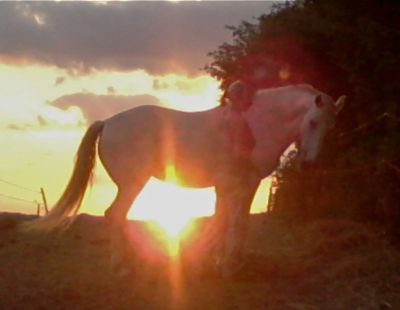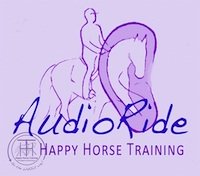|
Octavia's Story: Is An Aggressive Horse Brave or Just Insecure?
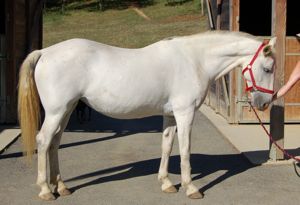
Octavia is a pure-bred Lipizzaner mare, not much taller than fifteen hands and about eleven years old. We took her on in October 2010 because her previous owner had decided that her only other option was euthanasia. We had been painted a fairly hopeless picture of this mare, and the decision to take her, going into winter when we were already pretty full up with horses, was all heart and no head!
She was also dangerous to ride, and her previous owner had been advised not to attempt to ride her again by her instructor after Octavia reared in a lesson at her yard. Not only was she an aggressive horse, she had physical problems too, described in the following quote from her previous owner in an email: "My little mare had her tendons scanned the other week and the vet discovered Navicular, a poorly check ligament and very bad sidebone!". The tendons in her front legs had also been swelling up persistently after her work, although her behavioural issues were largely attributed to hormonal imbalance and an unusually dominant temperament. "We shall take care not to vex the horse, or cause it to abandon its affable gracefulness in disgust. For this is like the fragrance of blossoms, which never again returns once it has vanished" - Antoine de La Baume Pluvinel Despite the situation she had ended up in, the first thing that struck us about Octavia was her obvious intelligence and interest in life. Whatever her behavioural issues were, she hadn't retreated into herself or become hardened to life yet, and although we knew things might be difficult with her, the fact that she still had her 'perfume' was a big plus. When she arrived she was confused, angry and lonely, she evidently had not been using her intelligence in a constructive way. Unfortunately for her, it was the people in her life who were making the decisions for her, and their lack of insight resulted in the state she had ended up in. In her case, a kind of 'worst of both worlds' situation had developed. On the one hand she was treated as if she was a dangerous monster, and on the other hand she was over-protected in an artificial lifestyle. Arguably the most destructive of all the influences which led to Octavia being labelled as an aggressive horse was people being frightened of her. 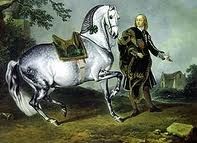
The Lipizzaner temperament is more inclined towards boldness and spiritedness, and they will rebel against the use of force. Like all horses, their respect must be gained through setting a good example, thus forming a relationship based on mutual respect. In their case, if this does not happen they will tend more towards aggression than timidity. Aggression is no less fearful than a more flight-based response, in fact it is often when they are most frightened that they lash out more readily in self-defense, and this can set up a vicious circle very easily. Horses, like people, are all individuals and can only be understood properly as such. For example, a dominant horse or a submissive horse in the herd may have a different way of relating to people than they would to another horse. Each particular relationship depends on the nature of the horse, their upbringing around other horses, and their exposure - positive or negative - to people.
It is the same with people, if a horse reacts in an aggressive way towards you, then there is fear in some way behind it, and identifying the reason is the key. An aggressive horse is of course not the same as a bossy or pushy one. It is important in all dealings with horses to be able to recognize the presence of fear, and unfortunately it is not always obvious. 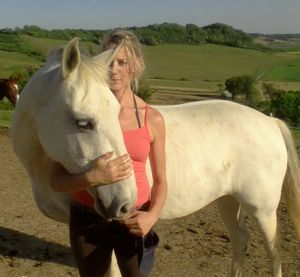
The answer to working with Octavia then, was simply not to be frightened of her, and to demonstrate that to her every time we were in contact with her. Her intelligence contributed to her downfall simply because she is highly sensitive to her handlers, and her insecurity leads her to 'test' how much they really care about her. This meant that it was crucial to genuinely care about her and treat her first and foremost with affection. To be frightened of her would mean that we had no faith in her, and thought her to be a genuinely aggressive horse, so of course she would lash out at the judgment. None of the horses we have yet encountered has been genuinely malevolent. Handling horses is an important part of their training, and it progresses just as the work under saddle does. Over time as Octavia's confidence in us grew, we could become more demanding in terms of her manners (which didn't exist previously!) which, by this point, served to increase her trust in us. If we had announced such expectations too early however, we might have turned her even further against people. Some examples of her previous 'lack of manners':
Overcoming What Went Wrong With Other horses: Is An Aggressive Horse Always A Dominant Horse? Octavia had built up a reputation as a dominant and aggressive horse with other horses, perhaps even more so than with people. It was true that her hocks were very badly capped when she arrived from kicking the trailer partition when she was travelled beside another horse. She also kicked the stable walls violently when we first put her beside another horse. In general though, horses as insecure as this will not be dominant members of a herd, and it is their self esteem that needs to be restored to enable them to function around other horses. Octavia's previous owner thought that if she was in a herd situation there would be more chance of finding a horse dominant enough to challenge her, whereas in reality she was similar to someone who has been kept in solitary confinement until they are traumatized by any kind of proximity with another human being. We don't know the circumstances wherein she lost her ability to interact normally with other horses, but we did know that she was normal as a youngster. Even horses who have been deprived of socialization very young seem to be able to re-integrate successfully into a herd, so in principle Octavia would not present too much of a challenge. When Octavia arrived we put her into a little field at first, where she would have the company of the friendly pigs in the next door field, and she was only exposed to the other horses when she came into her stable. That was tiring enough for her! Interestingly she made friends with the old arab mare who is at liberty here - she didn't seem to feel there was any threat from her. This mare also finds close proximity to other horses stressful, so maybe they understood each other. After about three weeks of this routine, Octavia was settling in. She was realizing that the people around her accepted her and cared about her, and so she began to have some energy to face her fears about other horses. 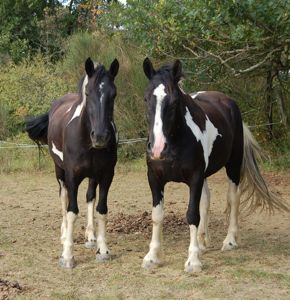
At first we put her out with two youngsters (photo right), full brother and sister, who are very self confident and had always lived in herd situations, so we hoped they would not be too hostile to her. The first time she really lived up to her aggressive horse label! It was the noises she made that were the most alarming, she almost screamed like a person at the same time as rushing backwards as fast as she could and aiming for the babies. The 'babies' is their nickname, but they were both very strong and well grown at the time. The look on their faces was comical, more towards the shock end of surprised. Although it was a bit unnerving, and she certainly gave a good show of being an aggressive horse, Octavia's display was more bark than bite, she was pushing her hindquarters into them more than kicking. Dominant horses tend to go in with their teeth first and then turn to kick, whereas she was not prepared to engage in a 'discussion' at all at that stage. The babies were great for her because they wouldn't give up trying to speak to her, and gradually the filly, who is a particularly dominant and outgoing character, began to impose herself. She seemed to be able to sense that Octavia's aggressive horse display was founded on insecurity, and every time they were together she would push a little bit more and take more of a stand. At the same time Octavia screamed less, defended herself less, and came closer to actually communicating. Initially Octavia could only cope with a few hours of this interaction, which soon became a whole day, but she always needed to go back to her 'safe' field at night to recuperate mentally.
It was surprising how exhausting it was for her to do what should have been natural for her. The other interesting thing we noticed about her was how she was often self-conscious in a way that didn't seem normal in a horse. Although it was obviously a relief for her to be alone again, she wasn't happy. Happiness and contentment would only come for her when she was a part of the whole again. One moment was particularly emotive, and a real turning point, during this period of 'normalization' undertaken by the babies (they definitely saw making Octavia 'normal' again as the task they had been been elected to take on, and they did it with dedication! They rarely let her slope off and be on her own in a state of dissociation, and they were quick to object if she didn't follow the proper horse herd code). This particular day, the babies had been grooming, and Octavia was watching a little wistfully. It helped that she had been coming into season, and Uno, the young gelding, approached her carefully and offered to groom. Up until now this kind of intimacy had been unthinkable for her, but this day she felt secure enough to respond - they groomed together, and it was a wonderful moment. It was the 17th of February, almost three months to the day after she arrived, that Octavia was ready to go out with the whole herd. There was no point in waiting any longer, but it was a bit scary when the moment actually came. After all, ten adult horses all with their own characters and points of view was a big step up from the babies. 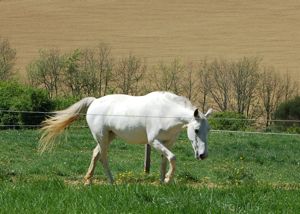
In fact there was no sign at all of the aggressive horse she had been, she strolled out down the lane of our Paddock Paradise, and started eating hay with one of the more dominant mares. The herd definitely gave her a break that first day, they seemed to know how much it mattered, and there was very little of the hounding and curiosity that can happen. As she had been in an adjacent field, they did already know her as well as they could do without actually being with her, which helped.
Of course, this day was only the beginning of the real integration for what had been such an apparently aggressive horse, unable to relate normally to other horses. She would have to eventually make alliances and eventually close friends, and this doesn't happen overnight for a mare who had become so estranged from horse society. All symptoms of the aggressive horse she had appeared to be however, were gone overnight. Interestingly she felt truly secure and her defensive behaviors, which were already on the way out, disappeared completely. She kept her distance from the others and never entered into the mutual fly-swishing sessions that summer, although she came close a few times. 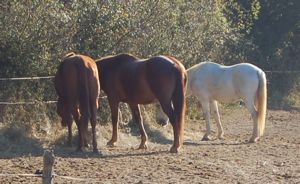
It was obvious before anyone got on Octavia that she had not been working properly, from her incorrect musculature, and the 'sewing-machine' trot she displayed on the lunge. This kind of a trot comes about when a horse is fixed in front by the rider so that not only are the natural paces disturbed, but the postural muscle are not being strengthened to allow for the riders weight, because the horse is not carrying himself. 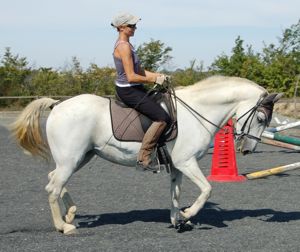
In this scenario, the rider must be doubly strong in their own posture, to support the horse and help them to begin to raise themselves into the engagement mechanism. This process is further complicated by the lack of any muscle memory for moving in this frame. In this picture you can clearly see the significant lifting of the abdominal muscles needed to lift Octavia into engagement. Here she is not yet strong enough to lift her neck any higher, hence her apparently 'overbent' head carriage (for more about the correct head-carriage see: Rollkur: A Valid Debate? At first in her work she had an artificially high and contracted head-carriage from having being strongly held in a double-bridle. She then progressed to being able to stretch-out more correctly, but went through a stage where she wanted to go very low and round with her neck. 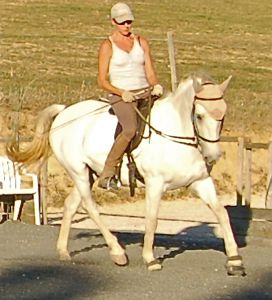
Now she is gradually building the strength to lift herself up onto a normal head-carriage. Interestingly, in the course of her first 6 months of re-training, her crookedness actually became more obvious than it was at the beginning - her bend became very unequal on each rein. This happened because her muscular compensations for a deep-seated crookedness that had never been addressed were unraveling with correct work in engagement. This was a positive step, because only once the unevenness expresses itself can we really begin to straighten the horse. After having undone the layers of stiffness that were compensating her crookedness, we were starting from scratch. Because she had always been held into her crookedness by the rider previously, she has very little strength in transmitting energy from behind within straightness.
The combination of her new herd life, suitable diet and the physiotherapy of her training smoothed out these habits quite quickly, but building up her postural strength and straightness is the work of a lifetime. Over time certain musculoskeletal issues would come up, mainly involving the places in her neck and back where the hollow way she had been moving before had resulted in spasms in the muscles etc. Cranio-sacral sessions re-patterned the nerves and released the restrictions so she could continue to strengthen in engagement. 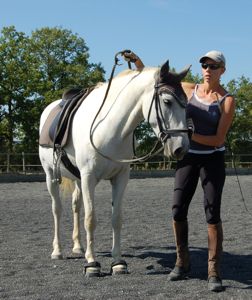
Her tendons and ligaments have never given us any trouble, and since she has been barefoot and in boots for her work, she has never been unsound. This is an impressive achievement, and a tribute to the toughness of the breed, considering the damage she will probably always bear from being shod before her feet had developed their adult size. 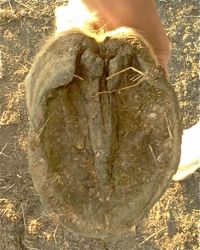
These photo's show how incredibly contracted her heels had become, with a corresponding cracked and withered frog. When we fist removed her shoes, there was a width of less than two inches between the heels! The deep groove between the bulbs of her heels, and the elongated shape of the whole hoof is also characteristic of shoe-damage. 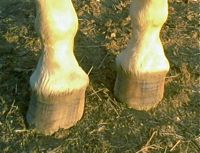
Due to the degree of heel contraction and hoof distortion, we initially assumed that Octavia must have been shod at a young age. However we recently found out from her breeder that she was actually barefoot until she sold her, so it must have been subsequent shoeing that did the damage, probably having a worse effect than usual because her feet are already very small and therefore more susceptible to contraction. Her feet have already greatly improved, although they will never fully recover from this distortion and weakness. See The Importance of Natural Horse Hoof Care for more on this.
Just like people, horses need affection in their relationships, they need their own kind as part of their own society, and they need to feel good physically. Even just one of these lacking will start to erode the self confidence of any horse, but each one supports the other, so simply observing what makes horses calm and happy instead of imposing our own values will always work. After all, our horses are our teachers. Relevant pages on Happy Horse Training that may interest you: Return from Aggressive Horse: Octavia's Story to Happy Horse training home |
New from HHT!
AudioRide is a series of exercises designed to listen to while you ride.
Audio descriptions guide you through each step of developing a balanced, dynamic connection with the horse through your position.
This truly innovative learning tool gives you a whole new way of being guided in your riding, in a calm, clear, step-by-step way.
Free Download! Introductory Exercise: Riding in the Now
Click here for full details
The Gymnastic Rider eBook
Now available exclusively from HHT! A unique, comprehensive guide to practical rider biomechanics. This professionally produced eBook takes the rider through the process of developing their body in the specific way that brings the horse's movement into harmony and balance - without force and constraint. Click here for full details, and to download the 15-page introduction for free.
Join the Happy Horse Training group on Facebook!
See and share topical info, news and photo's, and take part in lively discussions.
Click here to go to the HHT group and then click on the 'join group' button.
Join the Whole Horse Newsletter
HHT's free monthly newsletter giving you wide-ranging and intelligent insights into holistic horsemanship.
Just enter your details below to join.
Free bonus on the riding position with all new subscriptions: Ten Top Tips To Instantly Improve Your Connection With Your Horse.
Click here to see back issues of The Whole Horse newsletter
Train Your Horse
The Holistic Way
How To Train A Horse Without Force is a unique guide to training horses through energetic connection and gymnastic training. Part 1 covers everything on the ground, from handling to the lungeing technique that develops strength, straightness and engagement. Comes with a free eBook supplement on Horse Trauma.
Click here for more details.
What people say about the eBook:
"OMG! I'm BLOWN AWAY by this text [...] It's one of the best horse training texts I've ever read." - Wendy Kendall
"I realized that I haven't yet written you about the impact that your training e-book has had on me, and I want to let you know how inspiring and helpful I found it. As a student of Zen Buddhism for nearly three decades, I've often wondered when someone was going to write the book on Zen and the art of horsemanship, and I think that your emphasis on mindfulness and energy connection gets right at the heart of the matter. It has certainly deepened the way that I relate to and communicate with my horses. I am reasonably sensitive to horses' body language and mood, but new to me was the idea of feeling their energy in a more subtle way - including their connection with me even when I am not directly working with the them. I have made myself more aware of this communication, and it's pretty amazing. I have started grooming differently, too, treating a grooming session as a time to mindfully listen to my horse instead of a way to dust out an old rug (OK, I wasn't quite that bad, but you get the idea). Additionally, I have made myself more open to how I actually feel about the horses themselves - very enlightening. Overall, I think that you are saying something that no one else is saying but that everyone ought to hear." - Tess Lloyd
Do You Have
A Horse Story
To Share On HHT?
So many people have been through wonderful experiences with horses, whether in training or otherwise. If you've made a change in a horse's life - or one has made a change in yours - tell us about it here.
Learn How To Trim
Your Own Horse's Feet
The Simple Seven-Step Natural Trim is a comprehensive step-by-step guide to a cutting-edge barefoot trim. Click here to find out more.
What people say about HHT:
"The riding instruction is outstanding, if instructors in the UK taught this way there would be a lot of happy riders and horses."
"The riding tuition exceeded my hopes and expectations by a long way; giving me an exciting new facet to horsemanship which is lighter. more subtle, more elegant and more meaningful. It is as if a new door has opened bringing more sunlight and air."
"My goodness - what a change has taken place in my riding. I think that I'm starting to sit 'into' the horse rather than on top of him. I felt my horse's movements in a way that has almost never happened before"
Click on Testimonials for more





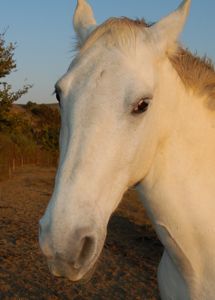
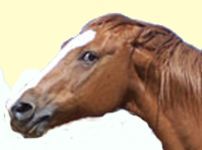 There is one rule that we have not yet come across an exception to however: aggressive behavior is a reaction to fear. When a stallion reacts aggressively, he may be frightened of losing the integrity of his herd. When a mare reacts aggressively to another mare over food she is worried she won't have enough.
There is one rule that we have not yet come across an exception to however: aggressive behavior is a reaction to fear. When a stallion reacts aggressively, he may be frightened of losing the integrity of his herd. When a mare reacts aggressively to another mare over food she is worried she won't have enough. 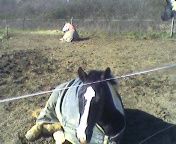
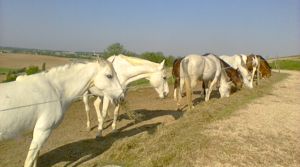 After that first day, the herd order settled down, and Octavia was at the bottom, as is normal for a new addition. The babies training had been exemplary, and she didn't incite any trouble due to a lack of herd manners.
After that first day, the herd order settled down, and Octavia was at the bottom, as is normal for a new addition. The babies training had been exemplary, and she didn't incite any trouble due to a lack of herd manners. 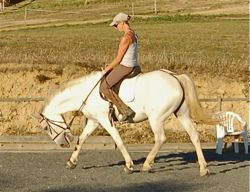
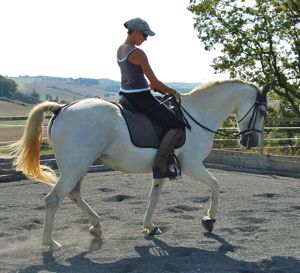 Because of this, it is very important during the on-going straightening process not to support her crookedness by allowing her to lean on one rein and avoid the contact of the other, with the corresponding displacement of the rider's weight from one side to the other. Instead it is crucial for the rider to maintain, posturally, the position of straightness, and stay there until the horse corresponds, constantly yielding the rein on the side the horse wants to lean on (in this case the right rein), and reconnecting it on the contracted side where the horse tries to back-off from the contact. Of course, a lot of postural strength and help from the leg aids must be used to maintain the bend, and align the horse's body.
Because of this, it is very important during the on-going straightening process not to support her crookedness by allowing her to lean on one rein and avoid the contact of the other, with the corresponding displacement of the rider's weight from one side to the other. Instead it is crucial for the rider to maintain, posturally, the position of straightness, and stay there until the horse corresponds, constantly yielding the rein on the side the horse wants to lean on (in this case the right rein), and reconnecting it on the contracted side where the horse tries to back-off from the contact. Of course, a lot of postural strength and help from the leg aids must be used to maintain the bend, and align the horse's body.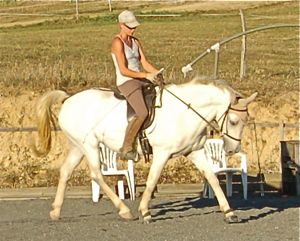 Gradually her short-striding shuffling action gave way to the beautiful open stride of the Lipizzaner as her balance improved and she could carry herself straighter. Her stamina has also increased - it is surprising how much running around a disengaged horse can cope with compared to the shorter length of time the same horse can work in engagement.
Gradually her short-striding shuffling action gave way to the beautiful open stride of the Lipizzaner as her balance improved and she could carry herself straighter. Her stamina has also increased - it is surprising how much running around a disengaged horse can cope with compared to the shorter length of time the same horse can work in engagement. 